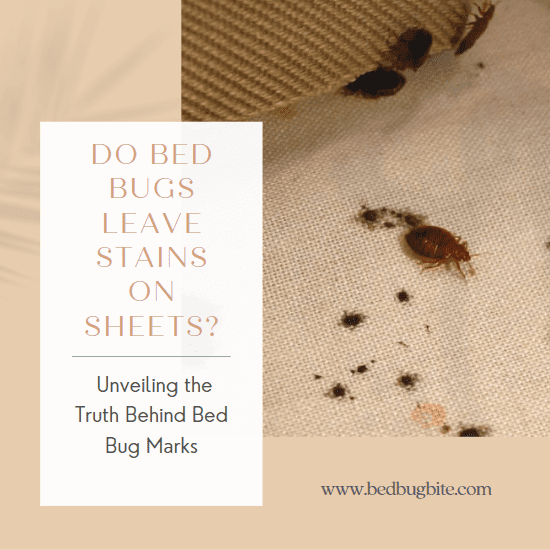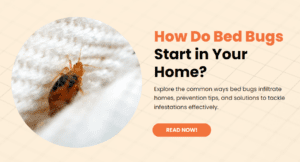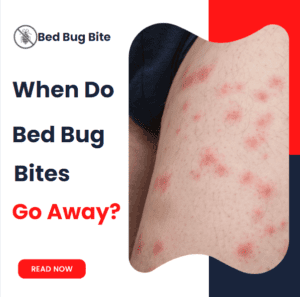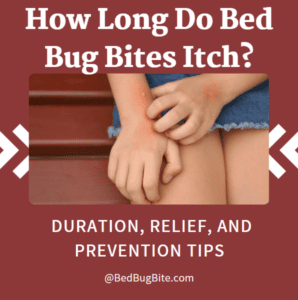Introduction
Welcome to our deep dive into one of the most unsettling concerns for any homeowner or renter: bed bug stains on sheets. It’s a topic that, unfortunately, many of us might encounter, yet few are prepared to tackle head-on. Bed bugs, those tiny, elusive pests, have a notorious reputation for invading our most personal spaces—our beds. Beyond the immediate discomfort and potential health implications of their bites, bed bugs leave behind a telltale sign of their presence: stains on our sheets. These marks are not just a matter of aesthetics; they signal an infestation that requires immediate attention. …Click here to Continue Reading about Bed Bugs!
In this comprehensive guide, we’ll uncover the truth behind the stains bed bugs leave, delve into their life cycle, and reveal how these pests make their way into our homes. Early detection plays a crucial role in managing and ultimately eradicating bed bug infestations. Ignoring the signs, such as mysterious stains on your bedding, can lead to a larger, more challenging problem.
Bed bugs feed on human blood, typically at night, leaving behind blood spots, fecal stains, and shed skins on sheets. Recognizing these signs is the first step in addressing the issue. However, identifying bed bug stains can be tricky, as they often resemble marks left by other sources. This guide aims to arm you with the knowledge to distinguish bed bug signs from other household stains, understand the implications of these unwanted guests, and explore effective strategies for removing stains and preventing future infestations.
Unveiling the Truth Behind Bed Bug Marks
Our goal is to provide you with actionable advice, supported by the most current, reputable sources. According to the Environmental Protection Agency (EPA), bed bugs are a growing concern in apartments, homes, and hotels across the United States. Their guidance emphasizes the importance of early detection and proper identification of bed bug signs, including stains on sheets . By staying informed and vigilant, you can protect your home and family from the nuisances and health risks associated with bed bugs.
As we navigate through this guide, remember that addressing a bed bug issue is not just about dealing with the immediate stains or discomfort. It’s about taking comprehensive steps to ensure your living space remains safe and pest-free. Let’s embark on this journey together, armed with the knowledge and strategies to tackle bed bug stains head-on.
Understanding Bed Bugs
Delving into the world of bed bugs begins with understanding these small, yet significant, pests. Bed bugs are parasitic insects that primarily feed on human blood, usually when their hosts are asleep. Their preferred habitats are mattresses, box springs, and any place that offers them close proximity to humans. Knowing about their life cycle is crucial; it comprises several stages from egg to nymph to adult, allowing them to multiply rapidly if not promptly addressed.
Understanding the Lifecycle of Bed Bugs
Bed bugs undergo a three-stage life cycle: egg, nymph, and adult. The females lay white, oval eggs in hidden locations, making detection challenging. These eggs hatch into nymphs, which require a blood meal to molt and progress through five nymphal stages before reaching maturity. The entire process from egg to adult can be completed in as little as a month under optimal conditions, leading to rapid population growth.
Habitats and Invasion Tactics
Bed bugs are master hitchhikers, moving from one location to another through luggage, clothing, and used furniture. They can also travel through small spaces in walls, making apartment buildings particularly vulnerable to widespread infestations. Their ability to survive for months without feeding makes them formidable opponents in the pest world. Recognizing the environments that are conducive to bed bug proliferation is essential in preventing their spread.
The Importance of Early Detection
Identifying a bed bug infestation early on can significantly reduce the effort and resources required to eliminate them. Regular inspections of bedding, furniture seams, and crevices are critical. Utilizing tools like bed bug detectors or encasements for mattresses and box springs can also aid in early detection and prevention. Awareness and education are your first lines of defense against these stealthy invaders.
By understanding the lifecycle, habitats, and behaviors of bed bugs, we equip ourselves with the knowledge necessary to detect their presence early and take proactive measures against infestation. This understanding not only helps in identifying the root cause of those mysterious stains on your sheets but also in implementing effective strategies to keep your home bed bug-free. Stay vigilant, and remember, knowledge is power in the fight against bed bugs.
Signs of Bed Bug Presence
Identifying the presence of bed bugs is pivotal in managing and ultimately eradicating these pests. While these insects are adept at remaining hidden, they inadvertently leave behind distinct signs of their presence. Among the most conspicuous indicators are the stains on bedding materials. These marks provide not only evidence of an infestation but also clues to its severity.
Primary Indicators of a Bed Bug Infestation
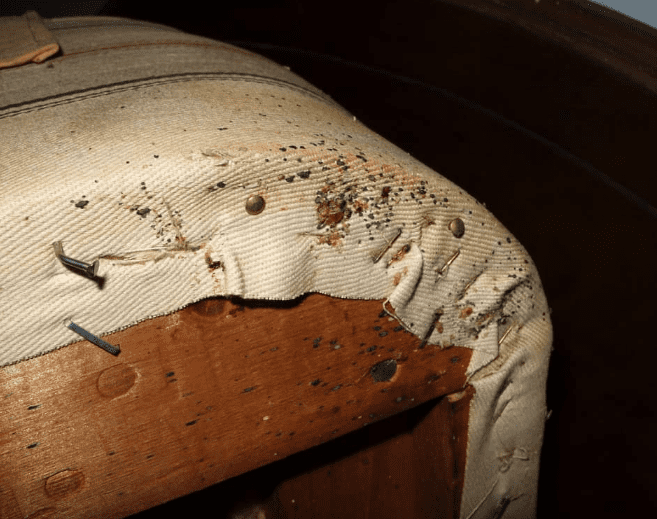
The signs of bed bugs extend beyond the mere sighting of the insects themselves. Look for small, rust-colored blood spots on sheets, which result from bed bugs being crushed or from their feeding process. Additionally, dark, tiny fecal spots that look like a marker dot are indicative of their presence. Another sign to watch for is the shedding of their exoskeletons, a process known as molting, which bed bugs undergo multiple times throughout their lifecycle.
Types of Stains Bed Bugs Leave on Sheets
1. Blood Spots: Often appear as small, reddish-brown dots—these are the result of bed bugs being squashed after feeding.
2. Fecal Spots: These are dark, round spots that occur when bed bugs excrete after feeding. They are usually found in clusters and may smear when wiped.
3. Exoskeletons: Finding tiny, shell-like remains on or around your bed is a strong indicator of a growing bed bug population.
Understanding these signs is crucial for early detection and intervention. Ignoring or misinterpreting these signs can allow an infestation to escalate, making it more challenging to control. Moreover, recognizing the difference between bed bug stains and those from other sources, such as spills or different pests, is essential for accurate identification and treatment.
By educating ourselves on the various indicators of bed bug activity, we become better equipped to take swift action. Early intervention can significantly reduce the spread of bed bugs and mitigate the damage and discomfort they cause. Keep an eye out for these signs and take immediate steps to address any potential infestation. Remember, when it comes to bed bugs, vigilance is your best defense.
Identifying Bed Bug Stains
Identifying bed bug stains on your sheets is a crucial step in recognizing and addressing an infestation. These stains can vary in appearance but are typically indicative of the pests’ nightly feeding routines and their subsequent activities. Understanding the nuances of these marks can empower you to take swift action, ensuring your sleeping environment remains both comfortable and pest-free.
Types of Bed Bug Stains
- Blood Spots: After feeding, bed bugs may leave behind small, rust-colored blood spots on sheets. These spots occur when bed bugs are crushed as the host moves or rolls over during sleep.
- Fecal Spots: Bed bugs also leave fecal stains, which appear as small, dark, ink-like marks. These are digested blood and can often be found in clusters or in a trail, indicating the pests’ movement.
- Exoskeletons: As bed bugs grow, they molt, leaving behind exoskeletons. These translucent, shell-like remains can be found on or near the bed.
Distinguishing Bed Bug Stains from Other Stains
Differentiating bed bug stains from other types of stains is vital for accurate identification and treatment. Blood spots from bed bugs are usually smaller and have a more rusted color compared to stains from other sources, such as spills. Fecal spots are unique in their dark color and placement in tight clusters or lines, unlike other stains that might be more randomly distributed.
By learning to identify bed bug stains accurately, you can take the necessary steps towards addressing the problem effectively. Recognizing these signs is not just about cleaning or changing your sheets; it’s about taking comprehensive action to eliminate the infestation and prevent its recurrence. Stay informed and vigilant, and remember, the sooner you detect these pests, the easier it will be to reclaim your peace of mind and ensure the health and safety of your sleeping environment.
The Implications of Ignoring Bed Bug Stains
Ignoring bed bug stains on your sheets is not just an oversight—it can lead to significant consequences that extend far beyond your bedroom. These stains are harbingers of an underlying infestation that, if left unaddressed, can affect your health and lead to a widespread problem throughout your home. Understanding the implications of overlooking bed bug stains is crucial for maintaining a healthy living environment and preventing the escalation of an infestation.
Health Risks Associated with Bed Bug Infestations
- Allergic Reactions: For some individuals, bed bug bites can cause allergic reactions, ranging from mild to severe. Symptoms may include itching, red welts, and, in rare cases, anaphylaxis.
- Sleep Disturbances: The presence of bed bugs can lead to anxiety and insomnia, as the thought of being bitten may keep you awake at night. This lack of sleep can have cascading effects on your overall health and well-being.
- Secondary Infections: Scratching bed bug bites can lead to skin infections, such as impetigo, ecthyma, and lymphangitis.
The Spread of Infestation
Ignoring the initial signs of bed bugs, like stains on sheets, gives these pests the opportunity to breed and spread throughout your home. Bed bugs are not limited to the bedroom; they can move to other areas, making eradication more challenging and costly.
Economic and Emotional Toll
Addressing a bed bug infestation requires time, effort, and resources. The longer the problem is ignored, the more extensive—and expensive—the treatment will become. Additionally, the stigma and stress associated with bed bugs can take an emotional toll, affecting your quality of life and peace of mind.
The consequences of overlooking bed bug stains are far-reaching, affecting your health, home, and wallet. Early recognition and action are paramount to preventing these negative outcomes. By understanding the risks associated with bed bug infestations, you can take proactive steps to eliminate these pests and safeguard your living environment. Remember, when it comes to bed bugs, vigilance is your best defense.
Effective Cleaning Techniques
Successfully removing bed bug stains from sheets is a critical step in managing a bed bug infestation and restoring your peace of mind. While the presence of these stains can be unsettling, the good news is that with the right approach, you can effectively eliminate them from your bedding. This section will guide you through effective cleaning techniques, ensuring you can tackle bed bug stains head-on and maintain a clean, healthy sleeping environment.
Effective Cleaning Techniques for Bed Bug Stains
- Immediate Action: As soon as you notice stains on your sheets, promptly remove the bedding and wash it in hot water. Bed bug stains are easier to remove when addressed quickly.
- High Temperature Washing and Drying: Bed bugs and their eggs can be killed by exposure to high temperatures. Wash your bedding at a temperature of at least 60°C (140°F) and dry it on the highest dryer setting.
- Stain Removal Products: For stubborn stains, pre-treat the affected areas with a stain remover before washing. Choose a product specifically designed to combat protein-based stains, as these are most effective against blood and fecal marks.
Preventive Measures During Cleaning
- Isolate Infested Bedding: To prevent the spread of bed bugs, keep infested bedding separate from clean laundry. Use plastic bags to transport infested items to the laundry area.
- Regular Inspection and Cleaning: Incorporate regular inspections of your bedding and surrounding areas into your routine. Vacuuming around your bed and washing your bedding regularly can help prevent future infestations.
Professional Cleaning Options
– If the infestation is severe, or if home cleaning methods do not remove the stains, consider seeking professional cleaning services. These services can offer specialized cleaning methods and treatments that are more effective against bed bug stains and infestations.
Removing bed bug stains from sheets may seem daunting, but with the right techniques, it’s entirely achievable. Prompt action, combined with thorough washing and preventive measures, can help you regain control over your sleeping environment. Remember, addressing the stains is just one part of managing a bed bug infestation. Comprehensive action, including professional extermination if necessary, will ensure that your home remains bed bug-free.
Prevention Strategies
Preventing bed bugs from invading your sleeping area is not only crucial for your comfort but also essential for maintaining a healthy and pest-free home environment. Bed bugs can cause significant distress, and their ability to hide and multiply quickly makes them formidable pests. Fortunately, by adopting effective prevention strategies, you can greatly reduce the risk of bed bug infestations in your home. This section will provide you with practical tips and measures to keep these unwanted guests at bay.
Practical Tips for Preventing Bed Bugs
- Regular Inspections: Regularly inspect your bed, furniture, and hidden corners for signs of bed bugs. Use a flashlight and magnifying glass to examine seams, folds, and crevices where bed bugs like to hide.
- Protective Covers: Invest in high-quality, bed bug-proof mattress and box spring covers. These covers are designed to encase the mattress and box spring, preventing bed bugs from entering or escaping.
- Minimize Clutter: Clutter provides hiding spots for bed bugs, making it harder to detect and eliminate them. Keep your sleeping area tidy and declutter regularly to reduce potential hiding places.
Travel Precautions
- Inspect Accommodations: When traveling, inspect hotel rooms or rental accommodations for signs of bed bugs before settling in. Pay special attention to the bed, furniture, and areas near the bed.
- Protect Your Luggage: Keep your luggage on a luggage rack away from the bed and walls. Consider using bed bug-proof luggage liners or encasements to protect your belongings.
Professional Assistance
- Seek Professional Help: If you suspect a bed bug infestation, don’t hesitate to seek professional pest control services. Early intervention by experts can prevent the problem from escalating and ensure a thorough eradication.
Implementing these prevention strategies can significantly lower the chances of a bed bug infestation in your home. By staying vigilant, conducting regular inspections, and adopting preventive measures, you can protect your sleeping environment from bed bugs. Remember, prevention is always better than cure, and taking proactive steps can save you time, money, and stress in the long run. Stay informed, stay prepared, and keep your home bed bug-free.
Conclusion
In conclusion, understanding the signs of bed bug infestations, such as stains on sheets, and knowing how to effectively address them are essential steps in maintaining a clean, healthy, and bed bug-free home. Throughout this guide, we’ve explored the lifecycle of bed bugs, identified their stains, and discussed the significant implications of ignoring these signs. Moreover, we’ve provided you with effective cleaning techniques and preventive strategies to help you manage and prevent bed bug infestations.
Key Takeaways
- Early detection and identification of bed bug stains are critical in preventing widespread infestations.
- Regular cleaning and the use of protective measures can significantly reduce the risk of bed bugs in your home.
- Professional assistance may be necessary for severe infestations to ensure complete eradication.
Additional Resources
For those seeking more information or needing further assistance, numerous reputable sources offer in-depth guidance on bed bug management. The Environmental Protection Agency (EPA) and the Centers for Disease Control and Prevention (CDC) provide valuable resources and recommendations for dealing with bed bugs effectively. Additionally, professional pest control services can offer personalized advice and treatment options tailored to your specific situation.
By taking proactive steps and staying informed, you can protect your home and loved ones from the nuisance and health risks associated with bed bugs. Remember, the key to a bed bug-free home is vigilance, prevention, and prompt action at the first sign of an infestation. Let this guide be your starting point in ensuring a peaceful and pest-free living environment.
We encourage our readers to stay educated, remain observant, and never hesitate to seek professional help when dealing with bed bug issues. Together, we can tackle the challenge of bed bugs and ensure the comfort and safety of our homes.

